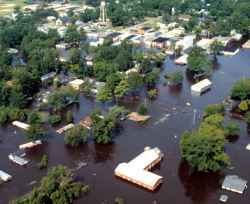 "In the 1970s, '80s, and '90s, inland flooding was responsible for more than half of the deaths associated with tropical cyclones in the United States." - Ed RappaportNational Hurricane Center
"In the 1970s, '80s, and '90s, inland flooding was responsible for more than half of the deaths associated with tropical cyclones in the United States." - Ed RappaportNational Hurricane CenterConsider the following:
When it comes to hurricanes, wind speeds do not tell the whole story. Hurricanes produce storm surges, tornadoes, and often the most deadly of all - inland flooding.
While storm surge is always a potential threat, more people have died from inland flooding from 1970 up to 2000. Intense rainfall is not directly related to the wind speed of tropical cyclones. In fact, some of the greatest rainfall amounts occur from weaker storms that drift slowly or stall over an area.
Inland flooding can be a major threat to communities hundreds of miles from the coast as intense rain falls from these huge tropical air masses.
Tropical Storm Allison (2001) produced extremely heavy rainfall and catastrophic floods in the Houston, Texas area. Allison then acquired subtropical characteristics and continued to produce heavy rainfall and flooding near its track from Louisiana eastward to North Carolina, and then northward along the U.S. east coast to Massachusetts. Forty-one deaths were directly related to the heavy rain, flooding, tornadoes, and high surf. Damage estimates reported by the Federal Emergency Management Agency (FEMA) were near $5 billion, with approximately $4.8 billion in the Houston metropolitan area alone.
Hurricane Floyd (1999) brought intense rains and record flooding to the Eastern U.S. Of the 56 people who perished, 50 drowned due to inland flooding.
Tropical Storm Claudette (1979) brought 45 inches of rain to an area near Alvin, Texas, contributing to more than $600 million in damages.
Hurricane Agnes (1972) produced floods in the Northeast United States which contributed to 122 deaths and $6.4 billion in damages. Long after the winds from Hurricane Diane (1955) subsided, the storm brought inland flooding to Pennsylvania, New York, and New England contributing to nearly 200 deaths and $4.2 billion in damages.
In a study from 1970 to 1999, freshwater flooding accounted for more than half (59%) of U.S. tropical cyclone deaths. These floods are why 63% of U.S. tropical cyclone deaths during that period occurred in inland counties.
At least 23% of U.S. tropical cyclone deaths occur to people who drown in, or attempting to abandon, their cars.
78% of children killed by tropical cyclones drowned in freshwater floods.
So, the next time you hear hurricane -- think inland flooding!
What can you do?
- When you hear hurricane, think inland flooding.
- Determine whether you live in a potential flood zone.
- If advised to evacuate, do so immediately.
- Keep abreast of road conditions through the news media.
- Move to a safe area before access is cut off by flood water.
- Do not attempt to cross flowing water. As little as six inches of water may cause you to lose control of your vehicle.
- Develop a flood emergency action plan.
- Have flood insurance. Flood damage is not usually covered by homeowners insurance. Do not make assumptions. Check your policy.
